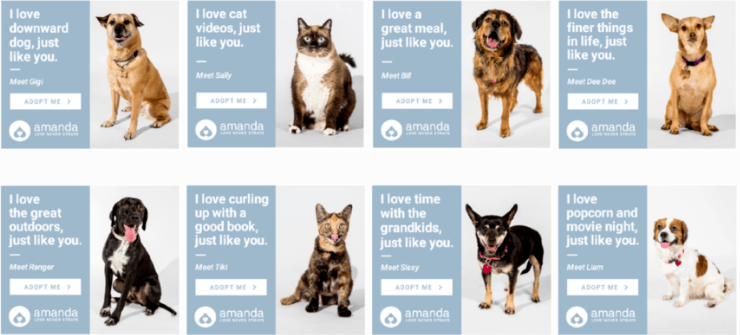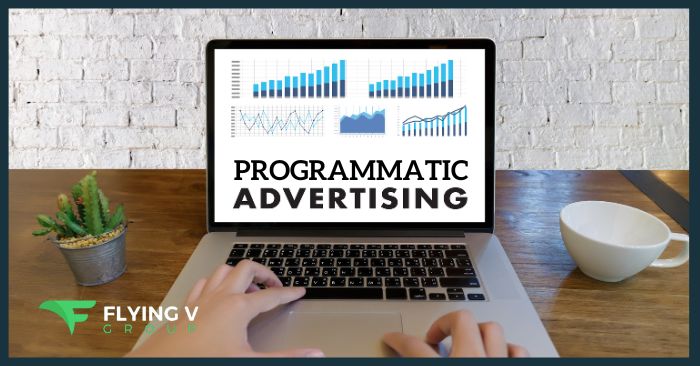As you explore examples of programmatic advertising, you’ll uncover solutions to the challenges you face in digital marketing. Understanding these examples is critical for you as a beginner entrepreneur, helping you to navigate a landscape dominated by data-driven decisions and automated ad processes. This article will guide you through successful campaigns, offering you the strategies and insights to tackle your marketing challenges effectively.
- 3 Successful Examples Of Programmatic Advertising
- Emerging Technologies Shaping Programmatic Advertising
- Consumer Behavior Trends and Their Impact in Programmatic Advertising
- Choose The Flying V Group Agency To Get Great Ad Results
- FAQs
- What are examples of programmatic advertising?
- Where are programmatic ads placed?
- What is the difference between programmatic and performance advertising?
- How do I set up programmatic advertising?
- Is YouTube considered programmatic?
3 Successful Examples Of Programmatic Advertising
1. Bliss Car Wash
In the competitive world of car wash services in Southern California, Bliss Car Wash faced a significant challenge: attributing their advertising efforts to tangible customer visits. Traditional online advertising offered little insight into how digital ads translated into physical car wash visits. This is where the Flying V Group stepped in, transforming Bliss Car Wash’s marketing strategy through the power of programmatic advertising.
The Challenge: Tracking Offline Conversions
For Bliss Car Wash, the issue was clear: How do you track a customer’s journey from seeing an online ad to physically visiting a car wash, especially when there’s no online transaction involved?
A customer might see an ad on Facebook, decide to visit the car wash, but this transition from digital impression to physical visit remained untraceable. Bliss Car Wash needed a solution that could bridge this gap and provide a clear picture of their advertising ROI.
The Flying V Group’s Innovative Solution
The Flying V Group, a renowned agency in the realm of programmatic advertising, introduced a game-changing strategy.
They implemented a sophisticated system that not only delivered targeted ads to potential customers but also tracked these customers’ movements through geofencing technology.
By creating a virtual perimeter around Bliss Car Wash locations, the Flying V Group could track when a device that had received an ad entered this area. This “geo-conversion” tracking was a breakthrough in measuring the real-world impact of online ads.
Impressive Results: Quantifiable Success
The results were nothing short of impressive. Under the adept guidance of Flying V Group, Bliss Car Wash saw a significant decrease in the cost-per-geo conversion, dropping from $55.28 to $34.45 per conversion. Moreover, the cost per thousand impressions (CPM) was reduced to an efficient $4.25.
The effectiveness of this approach was further highlighted by a remarkable 35% month-over-month increase in geo conversions and a 30% surge in website traffic.
The total reach of the campaign extended to 151,055 devices, with over 3 million impressions served across Southern California, illustrating the expansive influence of the campaign.
Entrepreneurial Insights: The Edge of Programmatic Advertising
This case study is a testament to the unique capabilities of programmatic advertising. Unlike traditional platforms like Google or Meta, programmatic advertising offers unparalleled targeting and tracking capabilities, allowing businesses to engage with customers more directly and effectively.
Entrepreneurs and business owners can draw valuable insights from Bliss Car Wash’s experience. The flexibility and specific targeting capabilities of programmatic advertising, coupled with more competitive advertising rates, present a compelling alternative to conventional online advertising channels.
A Roadmap for Digital Marketing Success
Bliss Car Wash’s journey with the Flying V Group illuminates a clear path for businesses looking to understand and enhance the ROI of their digital marketing efforts.
In an era where online-to-offline attribution is crucial, programmatic advertising stands out as a powerful tool in a marketer’s arsenal, driving not just impressions, but real-world conversions.
2. The Intercontinental Hotel Group (IHG)
The Intercontinental Hotel Group (IHG), known for brands like Holiday Inn, used programmatic advertising to rival booking platforms like Expedia. While the specific outcomes of these ads haven’t been disclosed, IHG has acknowledged the campaign’s significant success.
Notably, IHG’s ads showcased the cost benefits of direct booking, contrasting with the higher prices on external platforms. This strategy, rooted in transparency, directly displayed hotel rates, leveraging user browsing data for personalized ad experiences.

Though IHG hasn’t shared specific campaign results, their success suggests a major impact.
For your business, this underscores the power of clear, honest communication in advertising, especially about pricing and value. Such an approach can significantly influence customer decision-making, as seen in IHG’s campaign.
3. The Amanda Foundation
The Amanda Foundation, a non-profit focused on cats and dogs, innovatively used programmatic advertising to pair pets with ideal adoptive families. Recognizing diverse preferences in pet types, breeds, and energy levels, they leveraged user data for precise targeting.
This approach transformed their advertising into a digital matchmaking tool, linking pets with owners based on shared characteristics and lifestyle compatibility.

The campaign’s strength lay in its use of behavioral data, tailoring each ad to resonate with potential adopters’ preferences. This smart application of programmatic advertising led to numerous successful adoptions, showcasing its power in creating meaningful connections.
Focus on utilizing data-driven targeting in your marketing efforts. This involves understanding and catering to the specific preferences of your target audience, personalizing your marketing messages, and leveraging advanced technology for effective advertising. Doing so can create marketing strategies that resonate more effectively with your audience and yield tangible results.
Emerging Technologies Shaping Programmatic Advertising
Programmatic advertising is rapidly evolving, driven by advancements in several key technologies. Understanding these can help entrepreneurs harness them for more effective marketing.
- AI and Machine Learning: These are crucial for analyzing consumer behavior and improving ad performance, leading to better engagement and cost-efficiency.
- Blockchain for Security and Privacy: Blockchain enhances transparency and security, addressing privacy concerns and reducing fraud in digital advertising.
- AR and VR for Immersive Ads: Augmented and Virtual Reality create engaging ad experiences, like visualizing products in real environments or immersive brand worlds, increasing ad impact.
VR can create immersive brand experiences, transporting users to virtual environments that showcase products or services in compelling ways. These technologies lead to deeper engagement and can significantly enhance the impact of ads.
By integrating these emerging technologies, programmatic advertising can become more efficient, engaging, and secure, offering exciting opportunities for businesses to connect with their audiences.
Consumer Behavior Trends and Their Impact in Programmatic Advertising
Understanding evolving consumer behaviors is crucial for effective programmatic advertising as it ensures that marketing efforts align with current audience needs and expectations.
- Changing Consumer Preferences: Consumers now expect highly relevant and engaging content. For instance, a spike in eco-friendly product interest demands ads highlighting sustainable practices. Understand and anticipate these changing preferences to ensure your ads resonate effectively with your target audience.
- Personalized and Context-Aware Advertising: Personalization, based on browsing history or purchase behavior, significantly enhances ad effectiveness. Additionally, context-aware advertising, which considers the user’s environment, further increases engagement rates.
Consider a user searching for winter coats and being shown an ad for a local coat sale while it’s snowing outside. This level of personalization and context-awareness drastically improves engagement.
- Ethical and Privacy-Conscious Approaches: With rising concerns over data privacy, consumers respond better to brands that transparently handle data. A company openly seeking consent for data usage in its ads is more likely to earn consumer trust.
Adapting to these consumer behavior trends is essential for businesses looking to maximize the impact of their programmatic advertising efforts, ensuring they stay relevant and appealing to their audience.
Choose The Flying V Group Agency To Get Great Ad Results
Intrigued by the success stories from examples of programmatic advertising? Partner with Flying V Group to transform these complexities into successful strategies. Their expertise ensures that your business thrives in the ever-evolving programmatic advertising landscape.
FAQs
What are examples of programmatic advertising?
Examples of programmatic advertising include targeted display ads on websites, personalized video ads on streaming platforms, in-app advertisements, and dynamic ads in online games. These ads are tailored to specific audiences based on data like browsing habits and preferences.
Where are programmatic ads placed?
Programmatic ads are placed across various digital platforms including websites, mobile apps, video streaming services, and social media networks. They can also appear in digital out-of-home (DOOH) formats like digital billboards.
What is the difference between programmatic and performance advertising?
Programmatic advertising refers to the automated buying and selling of online ad space, using data to target specific audiences. Performance advertising focuses on achieving specific results like clicks, conversions, or sales, and often uses programmatic methods for placement.
How do I set up programmatic advertising?
To set up programmatic advertising, start by defining your target audience and campaign goals. Then, choose a Demand-Side Platform (DSP) to automate the ad buying process. Create and upload your ad creatives, set your budget, and use the DSP’s tools to target your audience.
Is YouTube considered programmatic?
Yes, YouTube offers programmatic advertising options. Advertisers can use platforms like Google Ads to purchase ad space on YouTube programmatically, allowing them to target specific audiences based on user data and behavior.






0 Comments